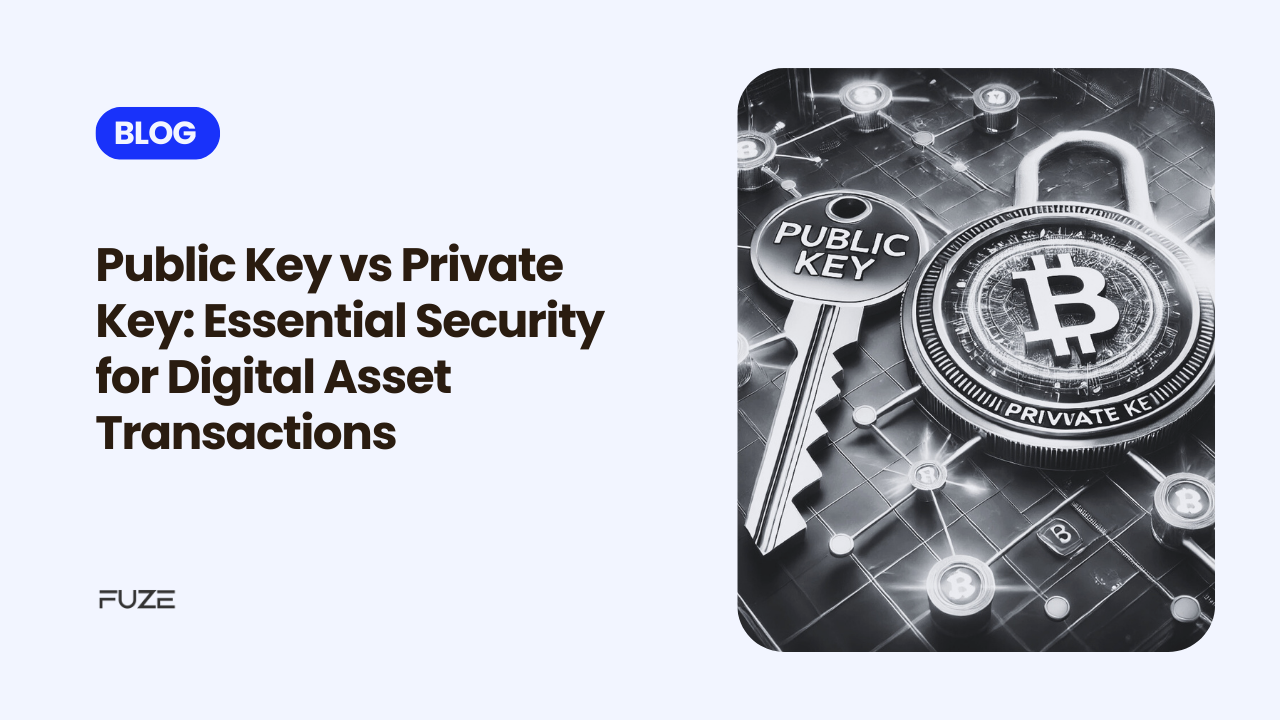As cryptocurrencies and blockchain technology continue to gain traction, understanding the mechanisms that secure transactions and ownership is critical for both users and businesses. Among the most essential elements of securing digital assets are the public key and private key. These two cryptographic tools work in tandem to provide the security, transparency, and privacy that blockchain technology is known for. In this blog, we will dive deep into the concept of public and private keys, how they function, and why they are crucial for digital asset transactions, especially for businesses looking to leverage crypto payments.
What is a Public Key?
The public key is an address or identifier that is visible and can be shared with anyone. It is analogous to an email address or a bank account number, allowing others to send funds to your crypto wallet. If you’re a business accepting cryptocurrency payments or an individual transacting with digital assets, the public key is the address you would share for others to send payments.
A public key is derived from the private key through a complex cryptographic process. While the private key is secret, the public key can be freely distributed without compromising security. It is widely used in various blockchain networks to facilitate peer-to-peer transactions. The most well-known example of this is Bitcoin, where the public key serves as your Bitcoin wallet address.
What is a Private Key?
In contrast, the private key is a secret cryptographic key known only to the owner of the associated public key. It is the key to accessing and controlling the digital assets in a particular wallet or account. If you lose your private key, you lose access to the funds stored in that wallet, and there’s no way to recover them. Therefore, the private key is one of the most sensitive pieces of information in the crypto world.
Private keys are typically stored in secure wallets—either hot (online) or cold (offline) storage—and are never meant to be shared. They are used to sign transactions, proving ownership and authorization to transfer digital assets. Without the private key, you cannot initiate transactions or transfer your digital assets to another address.
How Do Public and Private Keys Work Together?
Public and private keys are part of an asymmetric cryptography system.
Three fundamental steps can be used to summarise the process:
- Creating a Pair of Keys: The public key is shared with others, while the private key is kept confidential. The public and private keys are generated together. There is never any network transmission of the private key.
- Making Transactions: When someone sends you a cryptocurrency payment, they use your public key to know where to send the funds. The private key of the sender is then used to create a digital signature for the transaction hash.
- Transaction Verification: Once a transaction is signed with the private key, it is broadcasted to the blockchain network for verification. The public key can be used by others to verify that the transaction came from the rightful owner of the assets, ensuring that no one can alter or spend the assets without the private key.
This system provides an unbreakable link between the sender and the recipient of digital assets, ensuring that only the owner of the private key can initiate transactions.
Public and Private Keys in the Context of Blockchain Security
The combination of the public and private keys supports the entire security structure of blockchain transactions. The decentralised nature of cryptocurrencies ensures that no third party (such as a bank or payment processor) is required to validate transactions. Instead, cryptographic principles—specifically, public and private key pairs—are used to authenticate and authorise the transfer of digital assets.
For businesses accepting cryptocurrency, the public key is used to receive payments, while the private key is required to access and control those funds. This setup allows businesses to securely accept crypto payments without exposing sensitive information.
Why Is the Private Key So Important?
Losing access to your private key has irreversible consequences. Without it, you cannot access your cryptocurrency, and since the system is decentralised, there is no central authority (like a bank) to recover it for you. Therefore, it’s essential to protect your private key at all costs.
There are various ways to safeguard your private key:
- Cold Storage: Storing your private key offline in a secure physical location, such as a hardware wallet, ensures that it’s not exposed to online threats.
- Multi-Signature Wallets: A multi-signature (multi-sig) wallet requires multiple keys to authorise a transaction, providing an added layer of security.
- Backup and Recovery Plans: Businesses should have secure backup systems in place to ensure they can recover private keys in case of loss.
Public and Private Keys for Businesses Accepting Crypto Payments
For businesses accepting crypto payments, understanding and managing public and private keys is a critical part of the payment process. Here’s how these keys impact business operations:
- Receiving Payments: To receive payments, businesses must provide customers with their public key (i.e., wallet address). This ensures that the payment is sent to the correct destination.
- Securing Funds: Since the private key controls access to the funds, it must be stored securely. Businesses must take precautions to protect private keys from theft, hacking, or loss to prevent unauthorised access to their crypto assets.
- Transaction Integrity: Businesses can use their private key to sign transactions, providing proof of ownership and ensuring the integrity of the funds. When funds are transferred to a business wallet, the private key ensures that only the legitimate owner can move the assets.
- Transaction Speed and Efficiency: With the security of private and public keys in place, transactions can be processed directly between businesses and customers without the need for intermediaries. This reduces fees, increases speed, and eliminates unnecessary delays compared to traditional payment methods.
- Auditability and Transparency: Blockchain’s inherent transparency ensures that all transactions can be publicly verified via the public key, ensuring that businesses can audit and confirm transactions without relying on third-party intermediaries.
Risks Associated with Public and Private Keys
While the security provided by public and private keys is robust, there are risks if not managed correctly:
- Phishing Attacks: Attackers may try to trick businesses or individuals into disclosing their private keys through fraudulent communications or fake websites.
- Key Loss: If a business loses its private key and it isn’t backed up securely, they will lose access to the funds in that wallet permanently.
- Hacking: If an attacker gains access to a business’s private key (through poor security measures or online attacks), they can steal the funds associated with that key.
Best Practices for Managing Public and Private Keys
Businesses can minimise risks associated with public and private key management by following these best practices:
- Use Hardware Wallets: Store private keys in hardware wallets or cold storage devices to keep them offline and away from hacking threats.
- Implement Multi-Signature Wallets: Use multi-sig wallets to require more than one key to authorise transactions, adding an extra layer of security.
- Regular Backups: Backup private keys in multiple secure locations to ensure they are not lost or destroyed.
- Employee Training: Educate employees and stakeholders about the importance of key management and security practices to minimise human error.
Conclusion
In the world of cryptocurrencies and digital assets, understanding public and private keys is fundamental to ensuring secure transactions. For businesses accepting Bitcoin or other digital currencies, the ability to safely manage and protect these keys is a critical responsibility. While the public key allows businesses to receive payments, the private key provides the control and ownership of digital assets. Protecting private keys is paramount, as losing access to them can result in the irreversible loss of funds. By implementing best practices, businesses can safeguard their digital assets and embrace the benefits of cryptocurrency transactions, all while ensuring the security and privacy of their operations.
For businesses looking to accept Bitcoin and other cryptocurrencies seamlessly, Fuze offers a secure solution for integrating digital asset payments. With Fuze’s easy-to-use APIs and low fees, businesses can start accepting crypto payments today while ensuring their public and private keys are safely managed.
Disclaimer: Virtual assets carry significant risks, including high volatility and potential loss of your entire investment. They are not backed by governmental protections, and recourse may be limited in case of loss. Always assess your risk tolerance, fully understand the risks, and seek independent financial advice if needed before investing.
Frequently Asked Questions
1. What is the role of private and public keys in securing institutional transactions?
Private and public keys enable secure, tamper-proof transactions on blockchain networks. The private key is used to sign transactions, ensuring authenticity, while the public key verifies the signature, confirming the transaction’s integrity without exposing sensitive information.
2. How can institutions safely store private keys to prevent unauthorised access?
Institutions can store private keys securely using hardware security modules (HSMs), cold wallets (offline storage), or multi-signature wallets, which require multiple approvals for a transaction. Implementing robust access controls and encrypted backups further mitigates risks.
3. What happens if an institution loses access to its private keys?
If private keys are lost, the institution loses access to the associated digital assets permanently. To prevent this, institutions should implement key recovery strategies, such as shard-based key management or third-party custody services, to ensure redundancy and recovery options.
4. Can public and private keys be used beyond cryptocurrency transactions?
Yes, public-private key cryptography extends to various use cases, including secure communication, digital signatures for document verification, identity authentication, and access control within enterprise systems.
5. What are the risks of sharing public keys, and how can institutions address them?
While public keys can be shared without compromising security, associating them with sensitive activities might expose transactional patterns. Institutions can use hierarchical deterministic wallets or periodically generate new public keys to enhance privacy and reduce traceability risks.







